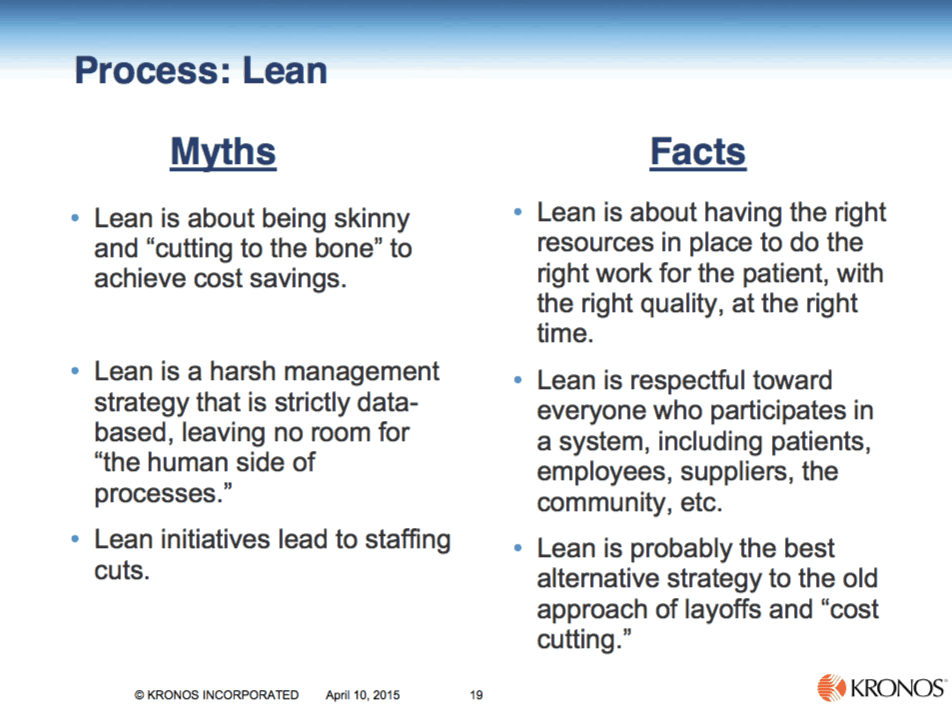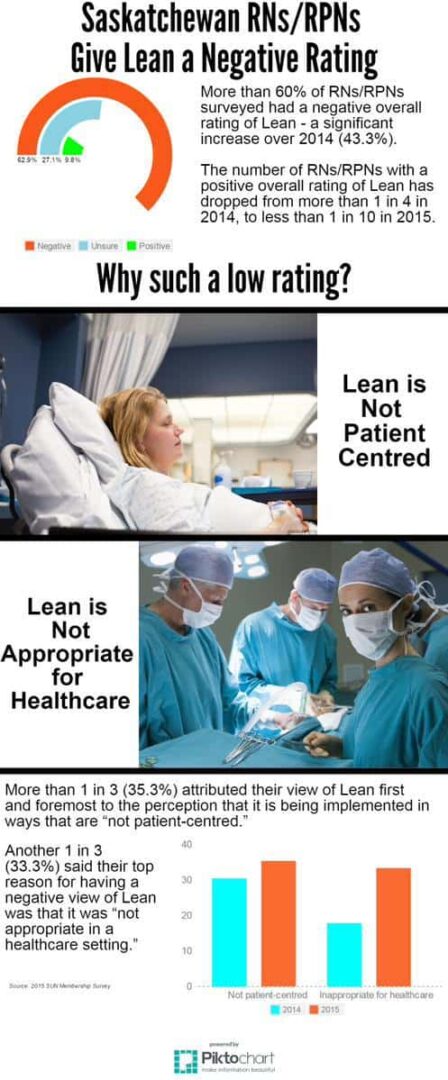
It's not uncommon to hear statements thrown around about Lean that are more of a myth than anything resembling reality.
I remember the time a professor told a group that if Toyota ran a health clinic, a buzzer would go off at the end of the planned appointment time and the patient would be kicked out of the room. That's ridiculous. That's a myth (and it's not one of the widely spoken myths).
A Lean myth might be an example of L.A.M.E. or “Lean As Mistakenly Explained.”
The past month or so, I've been giving some talks on Kaizen as part of a Lean workshop series that's sponsored by Kronos (sign up for June sessions in Houston or Seattle).
I was happy to NOT hear any Lean myths thrown around as truth at the Kronos events. It's a solid lineup of speakers with good things to say.
One of the Kronos speakers specifically addressed the idea that there are some “Lean Myths” and included this slide (click for a larger view):

This made me think about other Lean Myths and I tweeted some that came to mind (and a few others joined in):
It's a myth to think that every factory uses Lean principles at this point – or that they have really become a Lean culture instead of just using a few Lean tools.
I often run across people who are experienced project managers who, knowing nothing about Lean, get assigned to lead the Lean “implementation” as if this is like a piece of software you install.
I cringe when I hear people point out a warning sign and say, “Yay! A visual.” No, that's a bad attempt at error proofing and it usually doesn't work. See my blog BeMoreCareful.com for more about that.
And a final myth:
Listen to Mark read this post (subscribe to the series):
Myth: Lean is Not Patient-Centered
You might ask, “Well, who says Lean is not patient-centered?” The SUN nurses union in Saskatchewan has been throwing that around (including this tweet)… if they are really experiencing something that's NOT patient-centered, is it really Lean?

That infographic begs all sorts of questions — How were the survey questions asked? Were they biased questions? Was it a scientific sample of nurses?
There are enough positive reports about Lean in Saskatchewan, it makes me wonder where the disconnects are. Is it just political? The government presents some of the benefits from Lean (and here) and there are anecdotal reports that it's not all bad, not all doom and gloom, including this tweet from yesterday (one data point):
In my experience and the experience of many others, Lean IS patient centered. That's what Lean is all about… customer first, safety first, improving the patient experience. Dr. Don Berwick has said something like “Lean and patient-centeredness are the very same thing.”
Virginia Mason Medical Center proves that Lean *is* appropriate for healthcare and *is* patient centered (from this article and their books):
“Nurses who once spent most of their time fetching things they needed, walking as much as five miles a day to track down supplies, now have materials delivered to them and spend 90% of their time with their patients.
Previously, when a patient was hospitalized, staffers might trickle in one after another–nurse followed by doctor followed by nurse. Today, the whole care team of doctors and nurses and other support personnel enters the room together and greets the patient, with the doctor laying out a clear course of action. Colleagues constantly share data.”
Look at this video from Park Nicollet about their wonderfully patient-centered Lean-designed cancer treatment center:
Care “comes to you,” the patient. Patients are no longer walking from building to building in the snow. This is appropriate to healthcare. It's patient-centered.
Lean principles, going back to Toyota, say to focus on the customer and their needs. Unfortunately, that doesn't mean every hospital (or factory) that uses Lean tools (or is “implementing Lean”) adopts that mindset.
Read about the “loving care” philosophy of my friends from a Dutch hospital. How can you paint with a broad brush that Lean is not patient centered? The SUN union might have had bad experiences with Lean in Saskatchewan. Or, they're just picking a political fight. I don't know. The Lean I know is a wonderful thing and the nurses and patients I work with would agree.
What other Lean Myths do you hear about? Use the hashtag #LeanMyth if you want to share on Twitter or leave a comment below.
Please scroll down (or click) to post a comment. Connect with me on LinkedIn.
Let’s build a culture of continuous improvement and psychological safety—together. If you're a leader aiming for lasting change (not just more projects), I help organizations:
- Engage people at all levels in sustainable improvement
- Shift from fear of mistakes to learning from them
- Apply Lean thinking in practical, people-centered ways
Interested in coaching or a keynote talk? Let’s talk.
Join me for a Lean Healthcare Accelerator Trip to Japan! Learn More










I am a Registered Nurse, a member of SUN and a certified Lean Leader working in our Kaizen Promotion Office. LEAN is still in the beginning stages and it will take time to see all the benefits across our region. Staff who have experienced being on teams come out of the intense projects with skills, empowerment, excitement and hope for continued improvement. They can see where this is going, and are ready to keep working with their leadership to make a difference in patient safety, quality of care, staff efficiency and morale(reducing wasted steps, interrupions, duplicate paperwork). Communication has improved between team members and departments. We just need for more people to experience LEAN for themselves. It took a long time for our system to become as disfunctional as it was, and it will take time, persistence, patience, commitment and vision to improve it. I believe LEAN is the best tool/management system we can use, and we have to do something!
Thanks, Monica. Do you think the negativity about Lean, if it’s as widespread as SUN says, is due to
1) lack of communication about Lean?
2) lack of direct involvement?
It sounds like you’re proposing that the survey would have different results if you asked those who have been involved or around Lean as opposed to just having heard something?
Negativity reported as a result of the survey could be due to a few factors including what you mention:
1) lack of communication about LEAN (and negativity in the media as a result of politics),
2) lack of direct involvement,
3) how the questions were asked,
4) who decided to respond to the survey.
Knowing there is negativity regarding LEAN just means we need to do more so people understand we are just doing continuous improvement using a tool (that seems to work quite well by the way!)
A survey is just a survey, a snapshot of small group of people’s opinions, which may or may not represent the real picture. It would be interesting to survey RN’s who participated in RPIW’s or 5S projects (Rapid Process Improvement Workshops). I think the results would be very different.
Here’s a fine list of 10 Lean Healthcare Myths that happened to be published the day after this post… some overlap and some additions. It’s worth checking out:
http://icetechnologies.com/top-10-lean-healthcare-myths-busted/
Comments are closed.